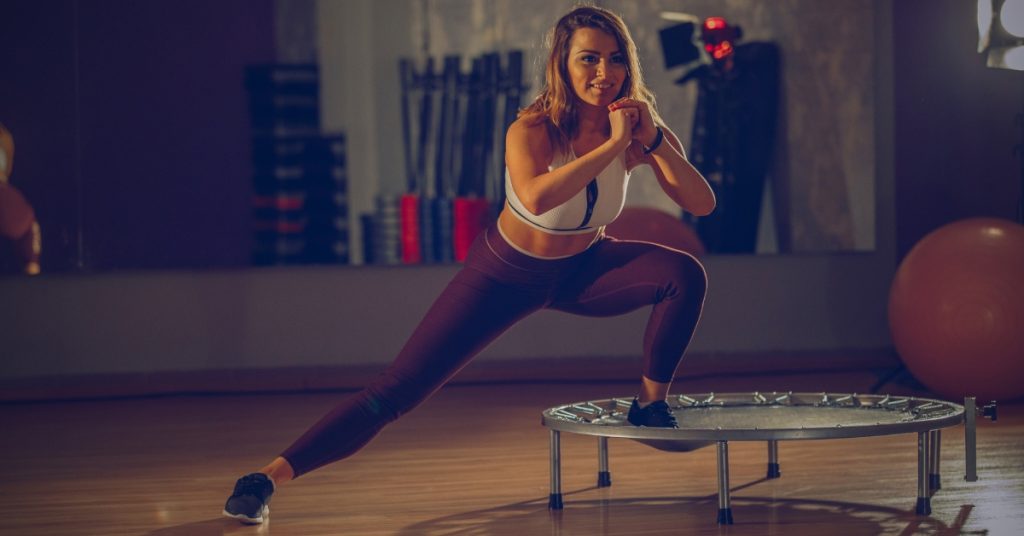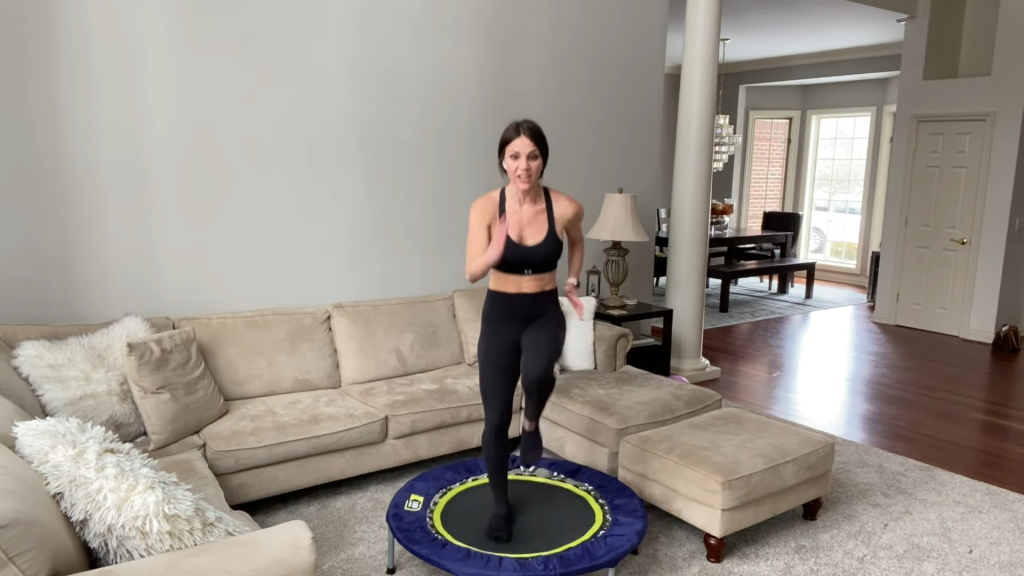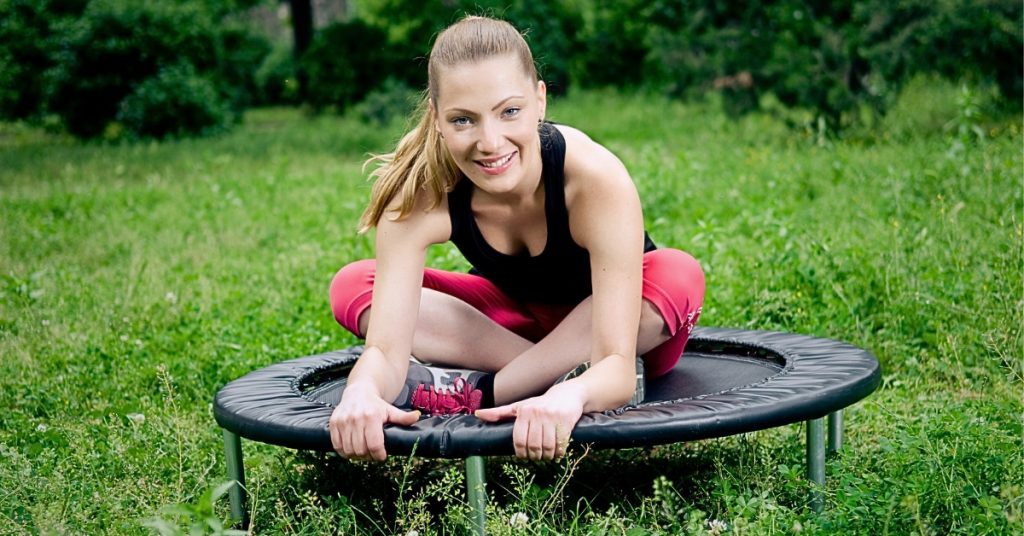Discover the fun and effective way to get fit with trampoline exercise! Start your fitness journey today with these beginner-friendly workouts.
Trampoline exercise has become an enjoyable and effective way to improve overall fitness. This exercise offers numerous health benefits, making it especially appealing for beginners looking to incorporate a fun and engaging workout into their routine.
Trampoline exercise provides a low-impact cardiovascular workout that strengthens the heart and lungs and helps enhance balance, coordination, and muscle tone.
Before starting trampoline exercise, it is essential to understand the safety precautions and equipment needed to ensure a safe and effective workout. Additionally, warm-up and stretching exercises should be performed before getting on the trampoline to prevent injury and prepare the body for movement.
This article will guide beginners through the various aspects of trampoline exercise, including basic bouncing techniques, cardiovascular exercises, core and balance exercises, and upper body exercises. Furthermore, after each session, it will provide instructions for cool-down and stretching exercises.
By following this comprehensive guide, beginners can gradually progress from simple bouncing techniques to more advanced trampoline exercises while reaping the maximum benefits of this enjoyable exercise form.
Trampoline Exercise For Beginners: Trampoline exercise is a fun and effective way to improve cardiovascular health and boost overall fitness. Jumping on a trampoline strengthens muscles, improves coordination, and burns calories. Start with small jumps and gradually increase intensity for a great workout!
Understanding the Health Benefits of Trampoline Exercise For Beginners

Trampoline exercise offers many health benefits, including improved cardiovascular fitness, increased bone density, enhanced lymphatic circulation, and strengthened muscles throughout the body. Engaging in trampoline exercise can significantly contribute to one’s overall physical well-being.
One of the primary health benefits of trampoline exercise is improving cardiovascular fitness. Jumping on a trampoline increases heart rate and oxygen consumption, enhancing the cardiovascular system.
Regular trampoline workouts have been shown to decrease resting heart rate and improve overall cardiovascular endurance.
Additionally, trampoline exercise has been found to increase bone density. The impact of jumping on a trampoline stimulates bone cells called osteoblasts, which promote the formation of new bone tissue.
This can be particularly beneficial for individuals at risk of osteoporosis or those looking to prevent age-related declines in bone density.
Moreover, trampolining enhances lymphatic circulation. The up-and-down motion facilitates the movement of lymph fluid throughout the body, removing toxins and waste products from tissues. This helps strengthen the immune system and promotes overall detoxification.
Lastly, engaging in regular trampoline exercises strengthens muscles throughout the entire body. The continuous bouncing engages various muscle groups, including those in the legs, core, arms, and back. This can lead to improved muscle tone and strength over time.
Incorporating trampoline exercise into one’s routine provides numerous health benefits such as improved cardiovascular fitness, increased bone density, enhanced lymphatic circulation, and strengthened muscles throughout the body.
Embracing this form of exercise can contribute to an individual’s overall well-being and assist them in their goal of serving others by being physically fit and healthy.
Safety Precautions and Equipment Needed for Trampoline Exercise
To ensure the well-being of participants, it is imperative to adhere to essential safety precautions and utilize appropriate protective gear when engaging in trampoline activities. Trampolining can be a fun and effective exercise method, but it can pose severe risks without proper protection.
Here are some trampoline safety guidelines to keep in mind:
- Always supervise: Trampolining should never be done unsupervised, especially by children. A responsible adult should always be present to monitor the activity and intervene if necessary.
- Secure the area: Before using a trampoline, ensure the surrounding area is clear of any obstacles or hazards. This includes removing sharp objects, providing ample space around the trampoline, and placing safety padding on hard surfaces nearby.
- Use necessary trampoline equipment: It is crucial to have appropriate equipment for safe trampolining. This includes a safety net enclosure to prevent falls off the trampoline, padding covering the springs and frame for added protection against injuries, and non-slip socks or shoes for better traction.
By following these guidelines and utilizing the necessary equipment, individuals can enjoy their trampoline exercise routine while minimizing the risk of accidents or injuries. Safety should always come first when engaging in physical activities like trampolining.
Warm-up and Stretching Exercises Before Getting on the Trampoline

Before engaging in trampolining activities, it is essential to incorporate warm-up and stretching exercises into your routine for optimal performance and injury prevention.
Warm-up routines are crucial as they prepare the body for physical exertion by increasing heart rate, blood flow, and core body temperature.
This helps loosen up muscles, making them more flexible and less prone to strain or injury during trampoline exercise.
Stretching exercises play a vital role in improving flexibility and range of motion. They help lengthen the muscles, tendons, and ligaments surrounding the joints, allowing for greater freedom of movement.
Incorporating stretching into your pre-trampoline routine can enhance overall athletic performance while reducing the risk of muscle imbalances or strains.
In addition to these physical benefits, warm-up, and stretching exercises also have psychological advantages. They allow one to focus on breathing and mental preparation before trampoline exercise.
This can help increase concentration levels while reducing stress or anxiety that may hinder performance. Integrating warm-up routines and stretching exercises into your trampolining regimen is essential for achieving optimal results and minimizing the risk of injuries.
You can improve overall performance while protecting yourself from potential harm by taking a few minutes before each session to warm up properly and stretch out tight muscles.
Getting Started with Trampoline Exercises
When you begin exercising on a mini-trampoline, take it easy and get accustomed to the new surface. Start with simple movements like marching or a gentle jog.
If available, use the stabilizer handlebar for balance, especially if you’re new to trampoline exercises. Gradually progress to more intense movements as you feel comfortable.
Basic Bouncing Techniques for Beginners
Incorporating the fundamental bouncing techniques into your routine can help you experience the joy and thrill of trampolining while building a solid foundation for more advanced maneuvers.
Before attempting any tricks or flips, it is essential to prioritize basic trampoline safety and choose the right trampoline.
Basic trampoline safety involves following a few guidelines to ensure injury prevention and an enjoyable experience. Firstly, always supervise young children when they are using the trampoline. Secondly, ensure the trampoline is set up on a flat and level surface away from any obstacles such as trees or fences.
Additionally, regularly inspect the trampoline for any wear or damage, including springs, mat, padding, and frame. Lastly, establish ground rules, such as no somersaults without proper training or supervision.
Choosing the right trampoline is crucial for both safety and performance reasons. Consider size, weight limit, durability, and stability when selecting a trampoline that suits your needs.
Opting for models with safety features such as enclosure nets and padded frames is advisable to minimize potential injuries.
By incorporating these basic bouncing techniques, adhering to safety measures, and choosing an appropriate trampoline model, beginners can confidently begin their journey into this exhilarating exercise.
Incorporating Cardiovascular Exercises on the Trampoline
One way to enhance the cardiovascular benefits of trampolining is by incorporating various aerobic exercises that can be performed on this dynamic apparatus.
Trampolining already provides a moderate level of cardiovascular exercise due to the continuous bouncing motion, which increases heart rate and oxygen consumption.
However, by integrating additional aerobic exercises into a trampoline workout routine, individuals can elevate their heart rate and maximize intensity levels. Cardiovascular exercises on the trampoline can include movements such as jumping jacks, high knees, and burpees.
These exercises engage large muscle groups in the body and require constant movement, resulting in increased oxygen and energy expenditure demand.
By performing these exercises on a trampoline surface, individuals benefit from the added cardio challenge and experience reduced impact on their joints compared to traditional forms of aerobic exercise.
The cardiovascular benefits of incorporating aerobic exercises on a trampoline are significant. Regular participation in these activities improves heart health by strengthening the cardiac muscles and enhancing blood circulation throughout the body.
Additionally, increasing intensity levels during trampolining workouts promotes weight loss, improves lung capacity, and boosts overall endurance.
Integrating various aerobic exercises into trampoline workouts enhances the cardiovascular benefits of this activity. Individuals can improve their overall fitness while minimizing joint stress by engaging in movements that raise heart rate and increase intensity levels on a trampoline surface.
The combination of bouncing motion with additional cardio exercises provides an effective means of achieving optimal cardiovascular health.
Strengthening and Toning Exercises for the Lower Body
A range of exercises can be performed on the trampoline surface to effectively target and strengthen the lower body, providing a challenging yet low-impact workout. Trampoline exercises offer an opportunity to engage various muscles in the lower body while minimizing stress on joints.
Incorporating strengthening exercises and toning workouts into your trampoline routine can help build muscle strength and improve overall endurance.
Here are five practical lower-body exercises that can be done on a trampoline:
- Jump Squats: Start with feet shoulder-width apart, then jump up explosively while lowering into a deep squat position upon landing.
- Lateral Jumps: Begin by standing on one side of the trampoline, then jump laterally to the other, landing softly with knees slightly bent.
- Single Leg Bounces: Stand on one leg and bounce lightly on the trampoline surface, maintaining balance and control throughout.
- Reverse Lunges: Step back with one foot onto the trampoline surface, lowering into a lunge position. Push off using your front foot to return to starting position.
- Calf Raises: Stand with feet hip-width apart and raise up onto your toes, then lower back down slowly.
Incorporating these strengthening and toning exercises into your trampoline routine will help you develop stronger leg muscles, improve balance and coordination, and enhance lower body strength.
Remember to start slowly if you’re new to these exercises and gradually increase intensity as you become more comfortable.
Core and Balance Exercises on the Trampoline

Core and balance exercises on the trampoline can significantly improve stability and overall athletic performance. These exercises target the core muscles, including the abdominals, obliques, and lower back.
Strengthening these muscles is essential for maintaining proper posture, preventing injuries, and improving overall body control.
One effective exercise for core stability on the trampoline is the seated bounce. This exercise involves sitting on the trampoline with legs extended straight out in front and bouncing up and down while engaging the core muscles to maintain balance.
The knee tuck jump is another exercise that targets core stability and coordination. In this exercise, one jumps off both feet and pulls their knees towards their chest while in mid-air before landing back on the trampoline.
To further emphasize how core stability exercises can benefit overall athletic performance, consider a comparison table:
| Exercise | Benefits |
|---|---|
| Seated Bounce | Improves core strength and stability |
| Knee Tuck Jump | Enhances coordination and explosiveness |
Incorporating these core and balance exercises into a workout routine can help individuals develop a strong foundation of stability and improve their coordination skills.
Additionally, these exercises can be modified to suit beginners by starting with smaller movements or reducing the intensity as needed. By consistently practicing these exercises over time, individuals can expect to improve their athleticism and physical well-being.
Adding Upper Body Exercises to Your Trampoline Workout
Incorporating upper body exercises into your trampoline workout can elevate the intensity and challenge of your routine, leaving you feeling empowered and accomplished.
By engaging your upper body muscles while bouncing on a trampoline, you can strengthen your core and lower body and target the muscles in your arms, shoulders, and back. This adds an element of resistance and coordination to your workout.
One effective upper body strengthening exercise on the trampoline is the trampoline push-up. Start by placing your hands shoulder-width apart on the trampoline mat, with your feet extended behind you in a plank position.
Lower yourself down towards the mat by bending your elbows, then push back up to complete one repetition. This exercise targets the chest, shoulders, and triceps.
Another variation is the trampoline plank walkout. Stand at one end of the trampoline mat and lean forward to place both hands on the mat. Walk your hands on until you are in a high plank position with only your toes touching the ground outside of the trampoline.
Then walk back towards the starting point using small steps with your hands until you return to a standing position.
By incorporating these upper body exercises into your trampoline workout routine, you can effectively engage all major muscle groups for a well-rounded fitness experience that promotes strength and balance throughout your entire body.
Cool-down and Stretching Exercises After Trampoline Exercise

After completing your trampoline workout, a cool-down and stretching routine is important to promote muscle recovery and prevent any potential post-exercise soreness or injury.
This routine should consist of gentle exercises that gradually lower your heart rate and stretch the muscles used during the workout.
Warm-up activities such as walking or slow jogging can be incorporated into the cool-down routine to promote further blood circulation and aid in cooling down the body.
Stretching after a trampoline exercise offers several benefits. Firstly, stretching helps improve flexibility by lengthening and loosening tight muscles. This can improve overall mobility and range of motion, making everyday activities easier.
Secondly, stretching aids in reducing muscle tension and promoting relaxation. It can help alleviate any muscle soreness or stiffness caused by the trampoline workout. Additionally, stretching can improve posture by releasing tension in muscles that may pull the body out of alignment.
Incorporating a cool-down and stretching routine after a trampoline exercise enhances physical well-being and provides self-care and reflection opportunities.
It allows you to reconnect with your body, appreciate its capabilities, and acknowledge the effort you put into caring for yourself through exercise.
By engaging in these post-workout practices, you demonstrate a commitment to your own health while also setting an example for others who may desire to serve themselves through fitness activities.
Progressing to Advanced Trampoline Exercises

After completing a trampoline exercise session, engaging in cool-down and stretching exercises is crucial to gradually allow your body to return to its resting state. These activities help reduce muscle soreness and prevent injury.
However, if you have mastered the basics of trampoline exercises and feel confident in your abilities, you may be ready to progress to advanced trampoline tricks.
Advanced trampoline exercises involve increasing the intensity of your workout by incorporating more challenging movements and combinations. These tricks require a higher level of skill, strength, and coordination. Some examples of advanced trampoline exercises include flips, twists, and complex aerial maneuvers.
To safely transition into these advanced techniques, it is essential to continue practicing proper form and technique while gradually increasing the difficulty level.
Always warm up before attempting any new trick or combination, and ensure that you clearly understand the movement pattern before executing it on the trampoline.
Safety should always be a top priority when progressing to advanced trampoline exercises. It is advisable to seek guidance from a qualified instructor who can provide proper instruction and supervision throughout your training.
By following this approach, you can continue challenging yourself on the trampoline while minimizing the risk of injury.
Related Article: 10 Trampoline Exercises for Beginners
Frequently Asked Questions:
Q.1 Can I do trampoline exercise if I have a pre-existing medical condition?
Individuals with pre-existing medical conditions should consult their healthcare provider before engaging in trampoline exercise. Trampoline exercise may have varying impacts on cardiovascular health and benefits for joint health, depending on the specific condition and individual circumstances.
Q.2 How often should I do trampoline exercises to see results?
The frequency and duration are important factors to see results from trampoline exercise. Engaging in trampoline exercise at least 2-3 times per week for around 30 minutes each session is recommended.
Q.3 Are there any age restrictions for trampoline exercise?
Safety precautions for trampoline exercise include proper supervision, regular equipment inspections, and avoiding risky maneuvers. The benefits of trampoline exercise vary among age groups, promoting cardiovascular health in adults and improving coordination and bone density in children and adolescents.
Q.4 Can I lose weight by doing trampoline exercise?
Trampoline exercise can contribute to weight loss by increasing calorie burn and improving cardiovascular fitness. Combine trampoline workouts with a balanced diet, regular exercise, and proper hydration to maximize weight loss.
Q.5 What should I wear when doing trampoline exercise?
Appropriate clothing is essential for safe trampoline exercise. To ensure safety, one should wear comfortable athletic attire that allows unrestricted movement and provides adequate support to minimize the risk of injury.
Conclusion:
In conclusion, trampoline exercise offers numerous health benefits and can be a fun and effective way to improve cardiovascular fitness, core strength, balance, and overall body conditioning.
By following proper safety precautions and using appropriate equipment, beginners can safely engage in trampoline exercise.
Starting with basic bouncing techniques and gradually progressing to more advanced exercises allows individuals to challenge themselves and continue making progress.
Incorporating warm-up, cool-down, and stretching exercises before and after trampoline workouts helps prevent injuries and promotes flexibility.
With consistency and dedication, beginners can enjoy the benefits of trampoline exercise while improving their physical fitness levels.
After reading this comprehensive guide on trampoline exercise for beginners, we hope you have gained a thorough understanding of the topic. If you have any questions, please feel free to leave a comment below. We are here to assist

![Trampoline Exercise For Beginners- compolte Guide [2023]](https://trampolinemind.com/wp-content/uploads/2023/07/Trampoline-Exercises-At-Home-21.jpg)